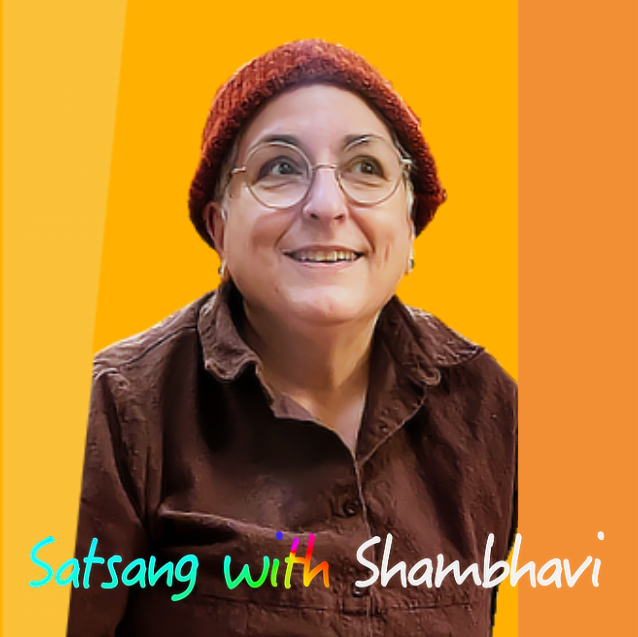Shambhavi riffs on the distinction between being present and being immersed in living presence. A podcast from Satsang with Shambhavi
STUDENT 1
Practicing presence: what is the role of that in Trika?
SHAMBHAVI
Why don't you tell me what you mean by 'presence'? And then maybe I can understand enough to answer that.
STUDENT 1
I guess, in, in Zen, it's like the, the meditations I've been exposed to are all sort of like, 'which body part do you want to focus on?'. Or 'what— what kind of sensation do you want to focus on?'.
SHAMBHAVI
Mmhm.
STUDENT 1
Or, like, 'are you just going to focus on all of it?', uh, for shikantaza. And where the— like, the goal is to sort of just be immersed in those sort of storyless sensations?
SHAMBHAVI
Mmhm.
STUDENT 1
Like how— yeah, I'm just kind of curious, like, how does that relate to what everybody's doing here?
SHAMBHAVI
[Laughs] Well, we're all attempting to do it. [laughs]
So there is a useful distinction that my Dzogchen teacher makes between ordinary presence and instant presence. Everything you're describing is ordinary presence.
So we are being aware of something: sensation, whatever else it is that you're focusing on or being aware of. This is called ordinary presence. It's just being less distracted from what is happening, in an ordinary way. Sensations are rather ordinary. Thoughts are rather ordinary. Breath is rather ordinary.
There's a wonderful practice that he gives for people who tend to get lost in thoughts of the past in the future. A practice of ordinary presence where we just narrate to ourselves very quietly and simply without a lot of affect what you're doing.
So, for instance, I would be narrating internally, 'I'm picking up my phone. I'm looking at my phone. I am putting in my password. I'm putting my phone down. I'm picking up the cup. I'm taking a sip out of— of the cup. I'm putting the cup down.' So this is ordinary presence. And focusing on emotions is exactly that.
When we talk about presence in Trika, we're talking about the essence-nature of all of reality. We're talking about an alive, aware Self— we call it Self, but it doesn't get called that in a lot of Buddhist traditions. We— also, we call 'the natural state'.
And from the perspective of Trika, that natural state is equal to, it's identical with the nature of our own selves. Our ultimate nature, the ultimate nature of the Self, uh, which could just be called the Self. Or it could be called God. But whatever you call it, there's no difference between inner and outer. Not like there's a 'God', and then a 'Self'.
Everything is full of consciousness. It's full of awareness and energy. And it's full of virtue, like compassion and mercy and wisdom and curiosity and playfulness and precision and clarity.
So when we are being immersed in living presence— alive, aware reality, the natural state, the Supreme Self, you could call it a million things. When we are being immersed in That, there is no focus.
So there is no paying attention to one thing, like sensation or breath or something like that. It is what we call samavesha. Samavesha means immersion. The gates of perception are relaxed and open, and there is clarity without any concentration.
So in Dzogchen, there's a distinction that's made between meditation and contemplation. In Trika and other kinds of traditions from India, there's a distinction between meditation or concentration. Dharana is concentration. Dhyana is meditation. And then the equivalent of contemplation would be sahaja, resting in the natural state.
What you're describing as the practices you've learned would fall somewhere along the lines of dharana (concentration) and perhaps meditation. It wouldn't be the same as sahaja or what's called trekchö or even shikantaza, as— at least as I understand it. But you may have a different understanding of it, because oftentimes these words mean different things to different teachers.
There is no witness in the state of natural contemplation. There's awareness. There's 'I' sense. There's experiencing. There's being immersed in that wisdom. But there's no sense of separation between That and this.
So there's not— no sense of the dualistic witnessing of something, as there often is with, for instance, the way Vipassana is taught in this country, and many sort of beginning meditation, or so-called meditation techniques.
So in this immersion, there's an, a sense that we're meeting something that is fully self-aware, blazingly intelligent [chuckles], full of life. And then, that it isn't— it is who we are. There's no distinction between It and us.
So my root teacher, Anandamayi Ma, called it That. She just called it That. You know, many traditions throughout the ages have been trying to describe That. To have a word for it. But there really isn't any word for it.
And that's why when you learn practices of natural contemplation, or simply resting in your real nature, natural— naturalness. Uncontrived, unconditioned naturalness. You don't receive instructions like focus on sensations. The instructions you receive are a different class of instruction.
And they're called 'pointing out instruction'. They're instructions that point you to something that you cannot be told how to do. There are no real instructions for how to immerse yourself in That or how to drop into That. I hope that makes it a little bit clearer.
STUDENT 1
There's so much emphasis on concentration. And there are those other teachings, the like, sort of the more absolute sort of 'there is no self' sort of teachings. And it's— it's always been confusing to me, sort of, like, where they meet up in Zen practi— or in, in, at least my community's practices.
SHAMBHAVI
Well, the teaching in Trike would not be that there is no self. It would be that your experience of Self is limited. And the idea would be to free that limited sense of self. So we could recognize the Self, which is everywhere. It's a little— it's a bit of a different teaching.
STUDENT 1
I've sort of been— I've sort of just been translating, like, your guys' Big Self to, like, Buddha-nature or something in Zen. But maybe that's not right.
SHAMBHAVI
Yeah, I think it's good not to do that.
STUDENT 1
Okay.
SHAMBHAVI
Uh, it's better to have a precise understanding of the view of this tradition, if you're so inclined, and then to understand where it might line up or not. But don't translate. There isn't— there isn't a one-to-one correspondence. And there are differences in view.
Particularly because you haven't walked the whole path of that tradition that you've been in.
STUDENT 1
Yeah.
SHAMBHAVI
So what you know of it is only relative teachings. And, so in, in a lot of the American Buddhist iterations of these traditions, but even in other countries where Buddhism was originated, there's a teaching method that's very different than this tradition and at— or Dzogchen.
So the teaching method in most of those traditions is that you receive relative teachings first, and then you receive absolute View at some other time, if you ever make it that far.
And then in the direct realization traditions, it's the opposite. You receive absolute View first. And you receive it along with relative view, but you receive absolute View as the container for relative view. And it can be very overwhelming for people sometimes. But that's the way it goes. [laughs]
So yeah. It's good to listen with— without any translation. Even if you feel you don't understand everything, that's fine. Nobody understands everything until they practice and hear stuff a lot of different times. So don't worry about that and feel free to ask questions for clarification as, as you have been.
STUDENT 1
Great. Thanks Shambhavi.
SHAMBHAVI
Mmhm.
STUDENT 2
Can you tell us something about how you chanced upon the meditation teachers that you chanced upon that you ended up liking a lot?
SHAMBHAVI
Mmm. Well, when I was studying with someone for a long time, he thought that I had a good connection to meditation. And so he told me to go seek out other teachers teaching open-eyed, non-conceptual meditation. And he suggested I start with Namkhai Norbu. [laughs] So that was very fortunate.
So I started going to teachings with Namkhai Norbu. And then... That wasn't the first teacher from Tibet I sat with though. The first teacher from Tibet I ever sat with was Tsultrim Gyamtso Rinpoche. And I've told the story so many times.
But I read— I was reading a Buddhist magazine (I don't remember which one it was) and there was an interview with him in there. He's kind of a crazy wisdom Kagyu teacher. I didn't learn meditation from him, but I learned a lot from him. He was, you know, other than Ma, the most realized teacher I ever had contact with. And just sitting with him was incredible.
Lama Wangdor was the best meditation teacher I ever had. You know, I was associated at that point with the Dzogchen Center in Berkeley. I'd been hanging out with them a lot. And he came and gave a, a teaching on Mahamudra meditation. It was, like, a retreat at the center there. So that's how I found out about that. [laughs]
Yeah, I've had other instruction from other enigma and Kagyu teachers of meditation, but nothing comparable to Lama Wangdor.
Sign up to receive email updates
Enter your name and email address below and I'll send you periodic updates about the podcast.


